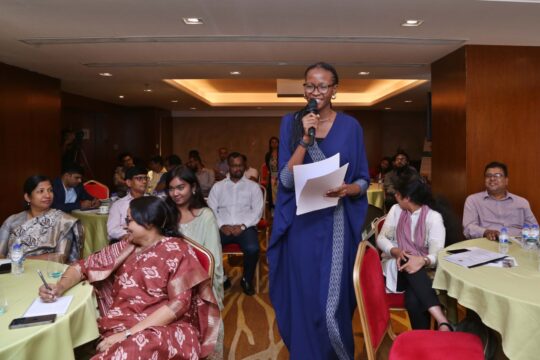The Directorate General of Health Services (DGHS) of Bangladesh with technical support from the Asian Disaster Preparedness Centre pilots its Hospital Disaster Safety Assessment (HDSA) Tool and Hospital Emergency Response Plan (HERP) Guideline at Baghaichari Upazila Health Complex of Rangmati on 6 and 7 December 2021 under the Strengthening Emergency Preparedness and Resilience in Bangladesh (SERB) Program. Piloting of these revamped tools is an exercise to validate their applicability in smaller local health facilities. After its pilot testing, the tool will be further improved and finalized for other Upazila Health Complex in Bandarban and Coxs Bazar.
SERB seeks to contribute to the aspirations of the Government of Bangladesh for achieving an integrated approach for emergency management at national, sub-national, and community levels. The main objective of the program is to strengthen the institutional and technical capacities of the partners, in preparedness for response and disaster resilience in Bangladesh.
Conceptualization of HDSA tool
As part of the technical capacity building, ADPC conducted Hospital Risk Assessment (HRA) in 23 Public Hospitals and HERP in 16 Public Hospitals from October 2013 to September 2019. The HRA and HERP were conducted using the Hospitals Safety Index (HSI) introduced by World Health Organisation (WHO). After which, a dissemination workshop was conducted to discuss the HRA and HERP findings. Recommendations suggested contextualizing the tools as per the requirement of primary, secondary, and tertiary hospitals, as many indicators were missing for conducting HRA and HERP. This led to the development of the HDSA and HERP tools at Upazila/Primary level under the leadership and guidance of DGHS in consultations with the World Health Organisation (WHO), National Institute of Preventive and Social Medicine (NIPSOM), and different hospital management specialists.
Conducting disaster safety assessments using the tools would result in a better understanding of the vulnerabilities in the health complex from a multitude of hazards and understanding the disaster risk that might disrupt the normal operations of the health facilities immediately after a disaster impact. The result of the assessment will facilitate the identification of priority areas where corrective action needs to be planned to enhance the preparedness and disaster resilience of the hospital.

The first day of the testing started with a brief introduction to SERB. Later, 21 participants from the health facility were divided into groups to test out the tools on various parameters. These key parameters were as follows:
- Hazards affecting the safety
- Structural Vulnerabilities
- Non-structural Vulnerabilities
- Hospital emergency and disaster management

The assessment of the tools was carried forward to the second day of the exercise. This was followed by a discussion on the viability of these assessment mechanisms. After careful deliberation, the participants highlighted the need of establishing a Hospital Disaster Management Committee. Dr. Mahabubur Rahaman, a participant, highlighted the lack of technical opinion and added, “The assessment could have been better if technical people were involved.” Another participant, Dr. Shawon Mollik suggested developing a Bengali translation of the tools for better understandability.
At the end of the session, Nur Begum, Senior Staff Nurse from the health complex, expressed her gratitude towards the instructors and ADPC. Golam Kabir, Consultant of HDSA, appreciated the participants and said, “I am very happy to see the active involvement from all the participants.”
Cover Photo by Freepik.


